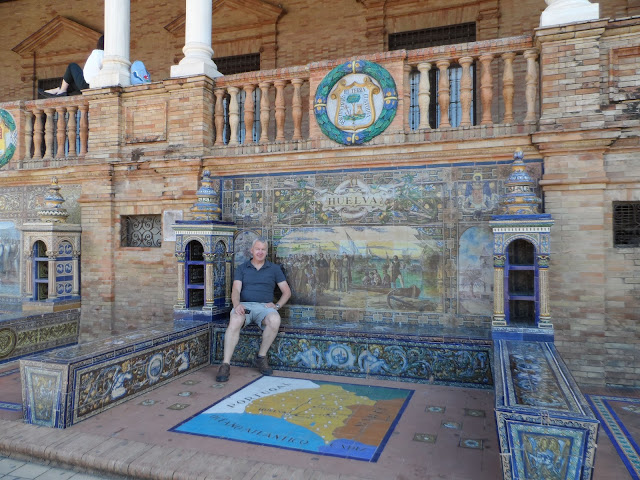It was a lucky thing that we weren’t too tired the other night (Monday), as brass insturments and drums were playing until midnight in Seville town and were
echoing all the way to poor old Sonny (our motorhome)! We wouldn't have minded music but to be fair this was a bit of a racket! We saw a parade go through Seville late afternoon, with the police blocking off
roads and streets and think it must of been connected to that. We have seen Easter
parades in Spain in the past that take place during Holy Week (usually last week of lent) – which is an annual tribute of the passion of Jesus, celebrated by Catholic
religious brotherhoods and fraternities that perform penance processions of the
streets - but this was different and way too early so we weren't sure what date in the religious calendar this was a celebration
of.
So having had a late night, we had a lazy morning and then couldn’t resist another
stroll around the Plaza de España to stretch our legs before setting off for
Jerez. We wanted to get a closer look at
the painted ceramic tiles along the wall.
There are 48 alcoves with benches, one for each province of Spain and
the 4 bridges represent the 4 ancient kingdoms of Spain: Castille, Aragon,
Navarre and Leon.
 |
| Provence of Huelva ceramic tile |
 |
| Tio Pepe iron icon on the road to Jerez |
It only took an hour to get to the Aire at Jerez,
which is about 5kms out of the town, on Avenida Tio Pepe (N36°42’47”
W6°06’34”). It’s the only one that you can stay on overnight and costs €15 a
night (includes electric, water, showers/toilets, also has a little
shop and a restuarant/bar next door). We even got a free sherry on arrival! Well, after
all, Jerez is famous the world over for its Tio Pepe sherry. Jerez is
derived from the arabic word - Sèrès, which
the British pronounces “sherry”. It’s also famous for flamenco and
it’s white horses.
It
was 26 degrees when we got here, so it was good to be able to have a ride into
the town on the scooter to cool us down. We had a walk up to the Alcázar, an 11th-12th century
fortress and is apparently one of Andalucía's best-preserved Almohad-era
(1140–1212) relics.
For us the cathedral was much more impressive, which dates
back to 1264 and was quite ornate inside. The cost was €5 per person, but that said there are quite a lot of paintings and artifacts to see. I went in but Mel wisely gave it a miss - he doesn't think it is right to pay to go into a church!
We were then hoping to do some sherry tasting at Gonzalez Byass (Tio Pepe) Bodegas, but tours finish at 5pm, so we we came back today (Wednesday).
The tour lasted about 1 ½ hours and you hop on and off a train to take you round all the bodegas (cellars) as it is so vast. Apparently, the large Tio Pepe weather vane is the biggest in the world (Guinness Book of Records)
 |
| Tio Pepe Weather Vane |
The bodega, Royal Winery of the Conch, was designed to celebrate the visit of Queen Elizabeth II of Spain in 1862. Inside there are a total of 214 casks full of
amontillado La Concha, bearing the flags of the 115 countries to which the
Gonzalez and Byass wine is exported.
 |
| Mel Standing to the left of the GB flag |
The tour was really interesting, explaining how it is made and incredibly that it is all done by hand. The grounds also house the first grass tennis court in Spain! The amount of casks in every bodega is incredible.
The very old bodega below was given by Manuel María González to
his uncle in recognition of the Tio Pepe that he named after him. I won’t bore
you with too much history but just to say around 1830, the González Byass company was established in Jerez by Manuel González (and his English agent, Robert Blake Byass), González had an uncle who lived
in Sanlúcar de Barrameda. Unlike Jerez, where sweet wines were preferred at the
time, the inhabitants of this village liked their wine very pale and very dry.
So, when this man came to visit his nephew, he brought along with him a few
casks of his favourite beverage, soon nicknamed "Uncle Joseph's wine"
which in Spanish translates as "Tio Pepe's wine". Very soon this wine
was to become famous all over Jerez and, in time, would achieve universal
recognition. The González family took sole control in 1988 but retained the name González Byass.
The Bodegas have been visited by many famous people, including Prince Philip, George and Edward VIII, Winston Churchill's Grandson, Steven Spielberg, Orson Wells, Cole Porter and Bobby Charlton, to name a few. All famous people who visit sign and date the casks, as below:
 |
| Prince Philip, Edward, George and the Ogilvy's |
 |
| Steven Spielberg, Orson Wells and Winston Churchill (in his honour, visited by his grandson |
 |
| Bobby Charlton (top left) |
Not sure if there was much sherry left after Keith Floyd's visit
in 1999!
Gonzalez Byass is also renowned for it's brandy making and the tour
included a visit around the distillery and an insight into how the brandy is
made.
Cheers or should I say Salud!

















No comments:
Post a Comment